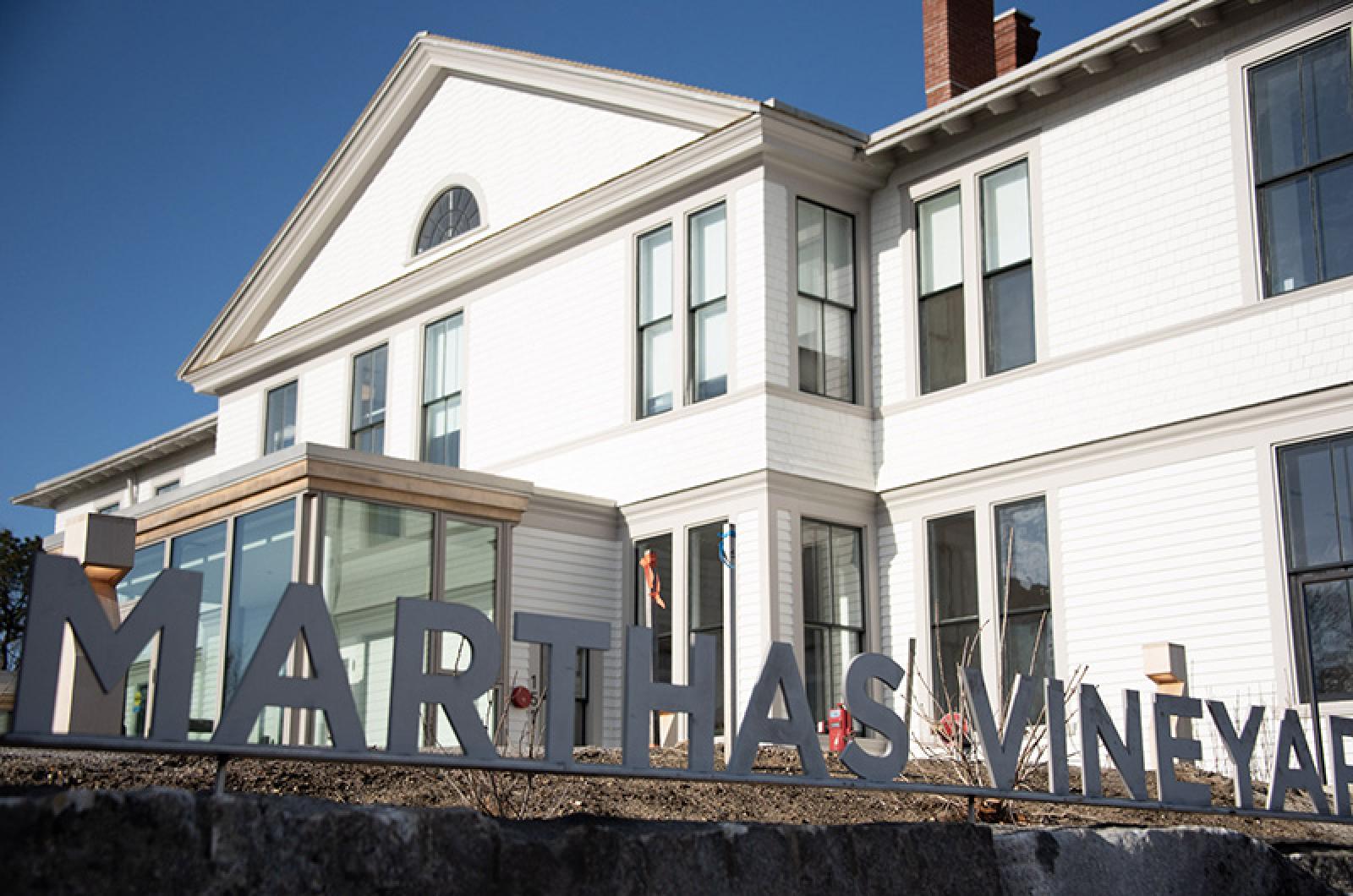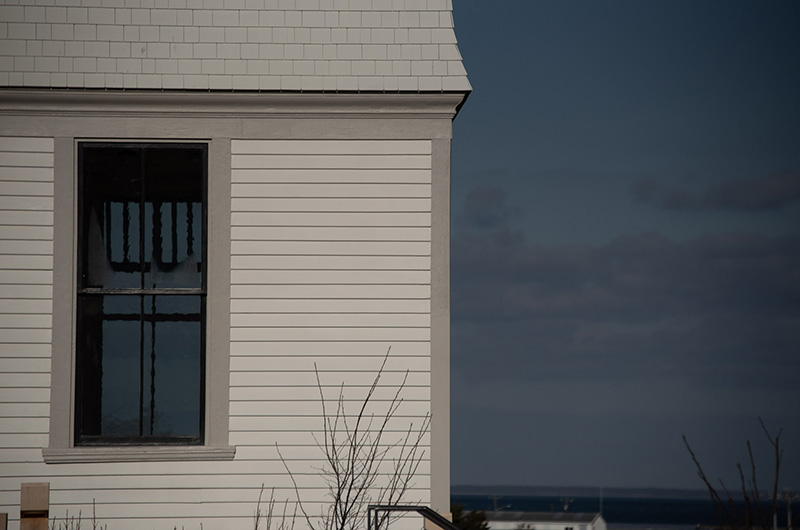As the Martha’s Vineyard Museum puts the finishing touches inside the renovated former Marine Hospital — now slated to open in March — more developments are occurring outside the building’s restored 1895 facade.
With the recent acquisition of a house at 174 Skiff avenue, the museum now owns three properties surrounding the main campus, noticeably increasing its footprint in the small Vineyard Haven neighborhood overlooking the Lagoon Pond.

The purchase of the Skiff avenue property closed last week for $800,000. Katy Fuller, museum operations manager who is overseeing the $31 million capital project, said the acquisition was made possible by an anonymous donor family. “We purchased it . . . but it was mortgage-free. The family paid for it,” she said.
In late spring of 2018, the museum acquired a home just east of its new property at 212 Skiff avenue for $1.13 million, also with the help of a donor. Then near the end of last summer, the museum bought a condemned house at 200 Skiff avenue for $425,000, according to land sale records. No donor was involved in that purchase.
In the latest Skiff avenue acquisition, Ms. Fuller said the property known as the Mitchell house went on the market last year after the owner died. She said the museum hopes to use the property for ADA accessible entrances and exits to the new campus. All public facilities in the state are required to be ADA accessible from the road, but the museum received a variance because it sits atop a
hill with a steep driveway. The Mitchell property will give the museum level roadside access, Ms. Fuller said.
“That house was one that we had long had our eye on, not really for the house but for the location of the land,” she said. “It’s right behind our property and flat.”
The Martha’s Vineyard Commission recently granted the museum approval to extend a sidewalk along the north section of Skiff avenue to ease access for people coming from the ferry, but Ms. Fuller said the new property will provide an access point for visitors who want to avoid or do not come through Five Corners.
“The location . . . actually allows us to put pedestrian and bike paths to the back of the property that would be much safer than going up the main driveway hill,” she explained. “So the purchase of this house was more so for the land and the accessibility of it.”
As for the house itself, she said the museum has explored the possibility of using it for collection storage or housing for summer interns, although nothing has been decided.
She said the museum is using the first floor of the house at 212 Skiff avenue for collection storage, while the second floor is being used as office space.
“The new building is ten million times better in terms of quality, but there still just isn’t enough of it,” Ms. Fuller said. “So 212 was acquired to house the rest of the collection that doesn’t fit on the main campus, and we did move some of the offices into this space, which allowed us to gain exhibit space in the main museum.”
She also said the house at 212 Skiff avenue was gifted to the museum from a separate donor who was interested in collection preservation.
The museum still does not know what it wants to do with the third house on the corner of Skiff avenue, Ms. Fuller said. Even though it is condemned, she said the museum has not received a permit to tear it down.
“It is basically a shack that is boarded up now,” she said. “We honestly don’t have plans for it yet.”
Ms. Fuller said the museum will not be actively pursuing any more properties in the neighborhood.
“We understand that we don’t need to keep buying up real estate,” she said. “Let’s open and prove ourselves and bring in the crowds that we promised, and make sure that people on the Island feel represented, and then we can look at our need from there.”
Meanwhile, the grand opening of the new museum originally planned for January has been delayed and is now planned for sometime in March. The facility received a certificate of occupancy on Dec. 21, but Ms. Fuller said about 10,000 square feet of exhibit installation still needed to be completed along with floor sanding and other finish work. A few Island groups have had sneak peaks, including the Martha’s Vineyard Chamber of Commerce and Oak Bluffs second graders, but others will have to wait until mid-March at the earliest for the opening.
“As much as we want to share the museum and give it back to the Island, there isn’t going to be a better time to do these floors right,” Ms. Fuller said. She expressed appreciation for Island contractor Mark Clarke, whom she said had been hired to buff and finish the floors following original work by an off-Island contractor
The general contractor for the project is Consigli Construction, a large firm originally founded in Milford with offices in Boston, New York, Maine, Connecticut and Washington, D.C., according to its website.
When the museum does finally open, it will offer Vineyarders an array of exhibits on the Island and its history. Permanent exhibits housed on the first floor will include a thematic history of the Vineyard, an interactive children’s play area called Hands-on-History, a pavilion surrounding the Fresnel Lens called Flashes of Brilliance, and an exhibit on shipwrecks. Upstairs, there will be exhibits on music and the 100th anniversary of the Migratory Bird Act. Come summer, those will make way for an exhibit on the renowned American painter and longtime Island resident Thomas Hart Benton, set to open June 28.
“It’s a cool exhibit that never been done before on the Island,” Ms. Fuller said. “We’ve been able to get paintings that we would have never gotten before because of the facility . . . It was, go big or go home.”
Outside the Fresnel Lens pavilion, the museum will also have a cafe operated by Island caterer Buckley’s Gourmet Catering. Ms. Fuller said the cafe will likely be open year-round with no admission fee requirement.
“I know there’s been a little delay, but we want to get it open, and it looks beautiful,” Ms. Fuller said. “We definitely think early March — come hell or high water, we’re just going to open.”








Comments (4)
Comments
Comment policy »